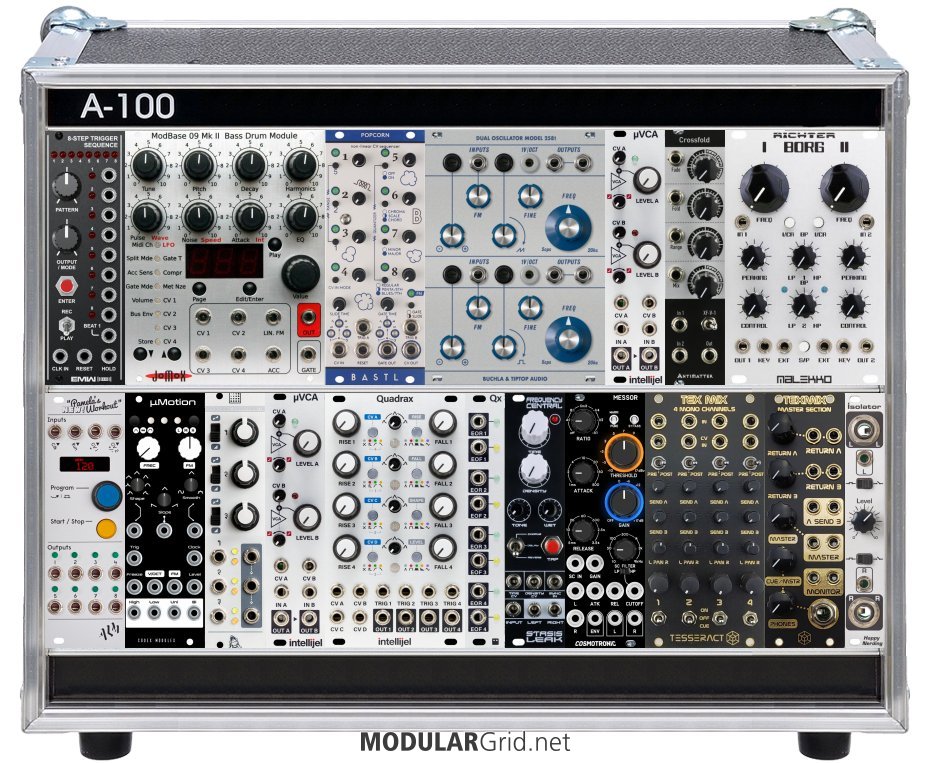Yeah, there's a lot missing here. For one thing, if this is to do all of those things you want, well...it's doable, but not in that cab. Gonna poke at this and get 'er set up right...
(a few minutes later)
OK...kick and bass. This has those in spades! I rebuilt the whole thing in an A-100 2x84 cab, for starters...and that's important, as the Jomox module you want is pretty deep. Given that the whole draw is nowhere near a Doepfer A-100P6's current load limit, plus the roadcase build on the cab itself, means that this is pretty much a goof-proof rig that'll work for both studio AND live use. Here's what's in there...TOP: First up is an EMW trigger sequencer, with 8 steps for each of 8 memories. This is for the Jomox, right next to it. Then a Bastl Popcorn handles your pitch sequencing (and it's internally quantized!) for the thing next to it...a Buchla 258t from Tiptop's collab line with Buchla USA. This oscillator is the grandpa of most complex VCOs out there, because it can internally modulate VCO1 against VCO2, or you can use one as a modulating suboscillator to get huge subbass notes. Or a lot of other things, for that matter. And to help do that, there's an Intellijel uVCA that'll allow you to impose modulation onto the output levels of each 258t VCO, so you could have VCO1 sounding, and then let VCO2 fade in its audio modulation to modulate it. Loads of possibilities...and if that's not interesting enough, the Antimatter Audio Crossfold wave processor allows you to create a composite waveshaped signal by having inputs for both 258t VCOs. Last up is the classic Wiard Dual Borg Filter, which is actually not merely a filter pair, but the individual filters can be switched into lowpass gate mode. This means you can use VCF1 there for timbral shaping, then set VCF2 to the lowpass gate mode and send it some fast envelopes for PUNCH.
BOTTOM: Pam's. You've got two sequencers, so you'll probably find it useful for those as well as other clocking/sequencing duties. The uMotion is a clone of the Mutable Tides; I'd have rather put in the actual thing, but the space dictated otherwise. Then a Mutable Shades and another uVCA handle the modulation treatments. An Intellijel Quadrax/Qx provides envelopes as well as further looped envelopes in case more LFOs come into play. And with the Qx, you can "cascade" envelope triggers and turn the whole thing into a really complex modulation source. Then we get into FX...the Stasis Leak gives you a tap-tempo delay, plus stereo reverb and/or stereo chorus, and the Messor is the stereo compressor with sidechain that you need to get that French House "pump" going. Branch off a signal from the kick, and there you go! For mixing, I went with a Tesseract Tex-Mix, so there's four mono inputs (with VCAs...these are your final audio chain VCAs), and the master module for that contains two AUX send/returns, your headphone preamp, a monitor/cue output, and pretty much a partridge in a damn pear tree! And last, a Happy Nerding Isolator...which you'll be very glad of if you take this to live gigs, with their typical janky AC. The Isolator does two things: 1) - it kills DC, and you want DC killed as excessive DC in your output will kill things like amps, speakers, etc. But it also 2) - prevents crud from getting into the modular via the outputs (ie: everyone's fave - ground loops).
So, yeah...it's bigger and it costs more. But it's now COMPLETE...and as low-end instruments go, this one might have what it takes to give ME and my top-secret CZ-101 subsine bass patch (has been known to cause structural damage! really!) a real run for the money. Plus, this is no sonic one-trick box...the bass voice architecture is loaded with modification tricks, the sequencers let you do set-n-forget setups, there's ample modulation and modifiers for that, and you get a true performance mixer on top of that that can be expanded with more Tex-Mix expansion modules when "M0AR" happens.
-- Lugia
Hi @Lugia
Thank you for your amazing and very informative answer. It goes beyond my expertise in modular field (which is close to zero), I had to read it more than once and I’m still reading it, again and again, to try to get it fully.
For now, are coming to my mind these questions:
FIRST ROW
- first module “the trigger sequencer” for the Jomox. I don’t know if I want to go just with a knob to assign steps to the sequence. I would prefer to do it with pads. Maybe even through a kind of MIDI controller (or keyboard)
- same for the synth part. I own an Arturia Keystep and I could use it to play and sequence the Bouchla 258t.
- the Antimatter Audio Crossfold seems cool (watching some Youtube videos) and the Dual Borg filter sounds amazing.
SECOND ROW
- not sure what to do with the PAM. It seems to be an impressive clock/sequencer. Should I use it to control the other two sequencers?
- why do I need another uVCA for envelopes? (noob question)
- Sidechain: watching Youtube videos I noted that side-chain effect can be achieved without compression. That’s why I added a Maths module in my rack. I don’t know which way is better though.
- With Tesseract can I connect the rack to my DAO via Fireface UCX and make a kind of hybrid system?
I have a few gears and I use Ableton. I would like to integrate the rack to the DAO.
So the rack will be my kick and bass ext module, the other gears (various synths) as .. synths, and the DAO my post-production point.


